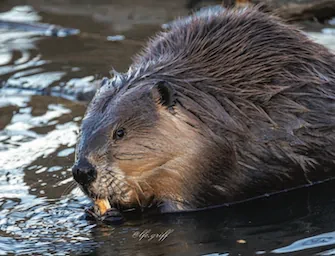When I was little, it was a tradition in our family to go for a walk after dinner to check on the beaver dam and to observe what the resident beavers were up to. Perhaps my parents were just looking for a way to burn off the energy of five children, or maybe they wanted to marvel at the ingenuity of these immense rodents. These walks were a source of joy and wonder as we would watch them go about their business, but if someone moved too loudly SLAP, the beavers would disappear from sight. For me, it was the start of a lifelong love for these fascinating creatures. Occasionally however, these walks ended in heartache as our family would come upon a place where the dam should have been only to discover that the authorities had removed it. I don’t know how my parents dealt with all of us up-in-arms that someone had dared to disturb our beavers.
As North America’s largest rodent, the beaver can easily be written off as a pest. However, if you take a broader perspective on community needs as a whole, especially with the current weather trends in Alberta, you might start to appreciate the many different ways that our national animal can enhance your local neighbourhood. Shall we dive in?
A beaver pond is more than what meets the eye. When they dam the water, they slow down the flow, creating less turbidity and generating pools that can be used as a nursery for aquatic insects and waterfowl. The abundance of water changes the types of aquatic vegetation that can grow in the pool and allows greater groundwater recharge. This allows for more terrestrial vegetation to take root. The build-up of silt on the pond-bottom and the other sediments trapped in the surrounding area enrich the riparian zone. This, in turn, attracts a higher diversity of wildlife from the mighty moose down to the sensitive amphibians.
Of more concern to humans though is the remarkable ability of beaver ponds to store water. A beaver is an incredible swimmer, but very cumbersome and vulnerable on land. In order to keep themselves and their families safe when transporting vegetation and trees back to the pond they will dig canals radiating away from the pond and under its surface. According to a study done in Elk Island Park, beaver ponds can store up to nine times more water than a pond of equal area with no beaver because of these canal features. With drought and the possibilities of another season of wildfires, extra water certainly has its appeal. On the other hand, in flooding events beaver dams and ponds have been shown to reduce negative impacts by absorbing some of the excess quantity and velocity of the water.
The truth of the matter is that if we want to prepare for drought and help mitigate the effects of wildfires in our province, we have to store more water on the landscape. There is no animal better equipped to make this happen than our patriotic beaver. Let us embrace what these ecosystem engineers who work 24/7 are offering free of charge.




























